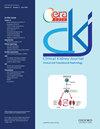Longitudinal serum bicarbonate and mortality risk in older patients with advanced chronic kidney disease: analyses from the EQUAL cohort
IF 3.9
2区 医学
Q1 UROLOGY & NEPHROLOGY
引用次数: 0
Abstract
Background and hypothesis We aimed to explore the relationship between serum bicarbonate (SBC) and mortality in advanced CKD during three distinct treatment periods: during the pre-kidney replacement therapy (KRT) period, during the transition phase surrounding the start of KRT (transition-CKD), and during KRT. Methods Using the EQUAL cohort, which includes patients aged ≥ 65 years and eGFR ≤20 ml/min per 1.73 m2 from six European countries, we explored the association between longitudinal SBC and all-cause mortality in three separate CKD populations: pre-KRT, transition-CKD and in the KRT populations, using multivariable time-dependent Cox regression models. We evaluated effect modification by pre-specified variables on the relationship between SBC and mortality. Results We included 1 485 patients with a median follow-up of 2.9 (IQR 2.7) years, during which 529 (35.6%) patients died. A U-shaped relationship between SBC levels and all-cause mortality was observed in the pre-KRT population (P = 0.03). Low cumulative exposure, defined as the area under the SBC trajectory before KRT initiation, was associated with increased mortality risk after transitioning to KRT (P = 0.01). Similarly, in the KRT population, low SBC levels showed a trend towards increased mortality risk (P = 0.13). We observed effect modification by subjective global assessment (SGA) category (p-value for interaction = 0.02) and KRT (p-value for interaction = 0.02). Conclusions A U-shaped relationship describes the association between SBC and mortality in the advanced CKD pre-KRT population, whereas in the KRT population a trend towards an increased mortality risk was observed for low SBC levels.晚期慢性肾病老年患者的纵向血清碳酸氢盐与死亡风险:EQUAL 队列分析
背景和假设 我们旨在探讨晚期 CKD 患者在三个不同治疗时期血清碳酸氢盐 (SBC) 与死亡率之间的关系:肾脏替代治疗 (KRT) 前时期、KRT 开始前的过渡阶段(过渡阶段-CKD)以及 KRT 期间。方法 我们利用 EQUAL 队列(包括来自六个欧洲国家的年龄≥ 65 岁且 eGFR ≤20 ml/min per 1.73 m2 的患者),使用多变量时间依赖性 Cox 回归模型,在三个不同的 CKD 群体(KRT 前、过渡-CKD 和 KRT 群体)中探讨了纵向 SBC 与全因死亡率之间的关系。我们评估了预先指定的变量对 SBC 与死亡率之间关系的影响。结果 我们纳入了 1 485 名患者,中位随访时间为 2.9 年(IQR 2.7 年),其间有 529 名患者(35.6%)死亡。在 KRT 前人群中观察到 SBC 水平与全因死亡率呈 U 型关系(P = 0.03)。低累积暴露量(定义为 KRT 开始前 SBC 轨迹下的面积)与转入 KRT 后的死亡风险增加有关(P = 0.01)。同样,在 KRT 群体中,低 SBC 水平也显示出死亡风险增加的趋势(P = 0.13)。我们观察到主观全面评估 (SGA) 类别(交互作用的 P 值 = 0.02)和 KRT(交互作用的 P 值 = 0.02)的效应修正。结论 在晚期 CKD KRT 前人群中,SBC 与死亡率之间呈 U 型关系,而在 KRT 人群中,低 SBC 水平的死亡率风险呈上升趋势。
本文章由计算机程序翻译,如有差异,请以英文原文为准。
求助全文
约1分钟内获得全文
求助全文
来源期刊

Clinical Kidney Journal
Medicine-Transplantation
CiteScore
6.70
自引率
10.90%
发文量
242
审稿时长
8 weeks
期刊介绍:
About the Journal
Clinical Kidney Journal: Clinical and Translational Nephrology (ckj), an official journal of the ERA-EDTA (European Renal Association-European Dialysis and Transplant Association), is a fully open access, online only journal publishing bimonthly. The journal is an essential educational and training resource integrating clinical, translational and educational research into clinical practice. ckj aims to contribute to a translational research culture among nephrologists and kidney pathologists that helps close the gap between basic researchers and practicing clinicians and promote sorely needed innovation in the Nephrology field. All research articles in this journal have undergone peer review.
 求助内容:
求助内容: 应助结果提醒方式:
应助结果提醒方式:


